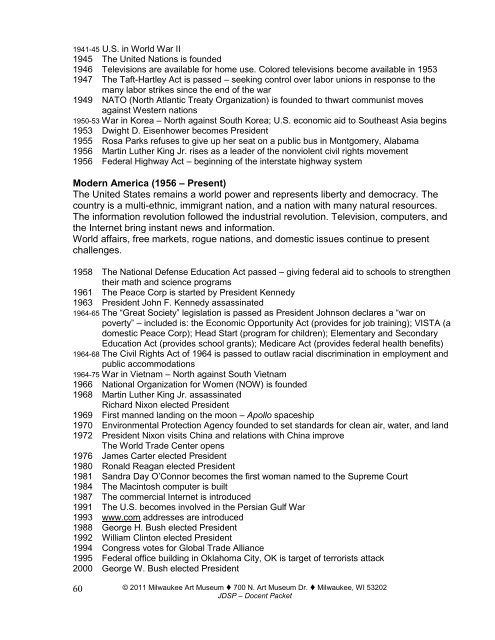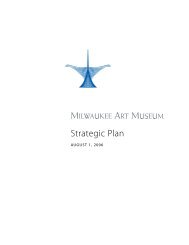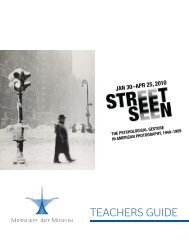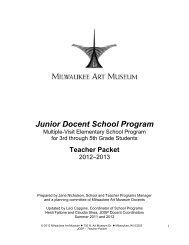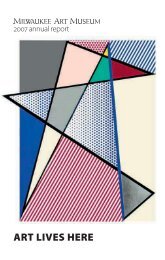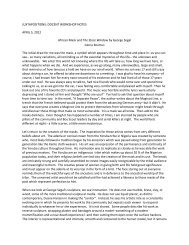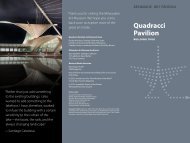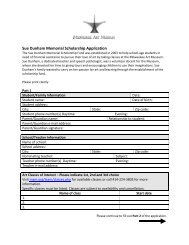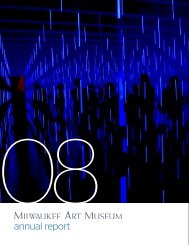Junior Docent School Program - Milwaukee Art Museum
Junior Docent School Program - Milwaukee Art Museum
Junior Docent School Program - Milwaukee Art Museum
You also want an ePaper? Increase the reach of your titles
YUMPU automatically turns print PDFs into web optimized ePapers that Google loves.
1941-45 U.S. in World War II<br />
1945 The United Nations is founded<br />
1946 Televisions are available for home use. Colored televisions become available in 1953<br />
1947 The Taft-Hartley Act is passed – seeking control over labor unions in response to the<br />
many labor strikes since the end of the war<br />
1949 NATO (North Atlantic Treaty Organization) is founded to thwart communist moves<br />
against Western nations<br />
1950-53 War in Korea – North against South Korea; U.S. economic aid to Southeast Asia begins<br />
1953 Dwight D. Eisenhower becomes President<br />
1955 Rosa Parks refuses to give up her seat on a public bus in Montgomery, Alabama<br />
1956 Martin Luther King Jr. rises as a leader of the nonviolent civil rights movement<br />
1956 Federal Highway Act – beginning of the interstate highway system<br />
Modern America (1956 – Present)<br />
The United States remains a world power and represents liberty and democracy. The<br />
country is a multi-ethnic, immigrant nation, and a nation with many natural resources.<br />
The information revolution followed the industrial revolution. Television, computers, and<br />
the Internet bring instant news and information.<br />
World affairs, free markets, rogue nations, and domestic issues continue to present<br />
challenges.<br />
1958 The National Defense Education Act passed – giving federal aid to schools to strengthen<br />
their math and science programs<br />
1961 The Peace Corp is started by President Kennedy<br />
1963 President John F. Kennedy assassinated<br />
1964-65 The “Great Society” legislation is passed as President Johnson declares a “war on<br />
poverty” – included is: the Economic Opportunity Act (provides for job training); VISTA (a<br />
domestic Peace Corp); Head Start (program for children); Elementary and Secondary<br />
Education Act (provides school grants); Medicare Act (provides federal health benefits)<br />
1964-68 The Civil Rights Act of 1964 is passed to outlaw racial discrimination in employment and<br />
public accommodations<br />
1964-75 War in Vietnam – North against South Vietnam<br />
1966 National Organization for Women (NOW) is founded<br />
1968 Martin Luther King Jr. assassinated<br />
Richard Nixon elected President<br />
1969 First manned landing on the moon – Apollo spaceship<br />
1970 Environmental Protection Agency founded to set standards for clean air, water, and land<br />
1972 President Nixon visits China and relations with China improve<br />
The World Trade Center opens<br />
1976 James Carter elected President<br />
1980 Ronald Reagan elected President<br />
1981 Sandra Day O‟Connor becomes the first woman named to the Supreme Court<br />
1984 The Macintosh computer is built<br />
1987 The commercial Internet is introduced<br />
1991 The U.S. becomes involved in the Persian Gulf War<br />
1993 www.com addresses are introduced<br />
1988 George H. Bush elected President<br />
1992 William Clinton elected President<br />
1994 Congress votes for Global Trade Alliance<br />
1995 Federal office building in Oklahoma City, OK is target of terrorists attack<br />
2000 George W. Bush elected President<br />
60<br />
© 2011 <strong>Milwaukee</strong> <strong>Art</strong> <strong>Museum</strong> 700 N. <strong>Art</strong> <strong>Museum</strong> Dr. <strong>Milwaukee</strong>, WI 53202<br />
JDSP – <strong>Docent</strong> Packet


